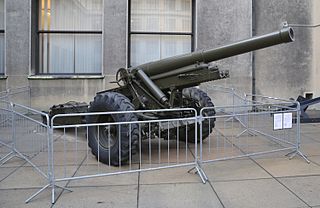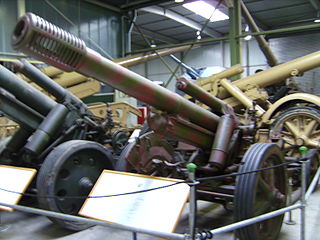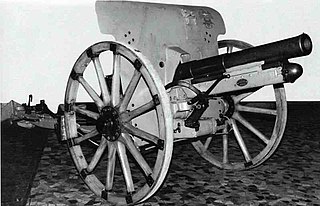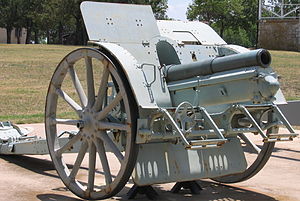
The howitzer is an artillery weapon that falls between a cannon and a mortar. It is generally aimed lower than a mortar but higher than a cannon. With their long-range capabilities, howitzers can be used to great effect in a battery formation with other artillery pieces, such as long-barreled guns, mortars, and rocket artillery.

The Skoda 7.5 cm Gebirgskanone M. 15 was a mountain gun used by Austria-Hungary in World War I. In German service, it was known as the 7,5cm Skoda Geb. K. M. 15. The Italians designated them as the Obice da 75/13 and the Wehrmacht would designate captured guns as 7.5 cm GebK 259(i) after the surrender of Italy in 1943.

The Škoda 149 mm K series was a line of heavy howitzer designs used by Germany, Turkey, Romania, Slovakia, and Yugoslavia during World War II.

The 152 mm howitzer-gun M1937 (ML-20), is a Soviet heavy gun-howitzer. The gun was developed by the design bureau of the plant no 172, headed by F. F. Petrov, as a deep upgrade of the 152-mm gun M1910/34, in turn based on the 152-mm siege gun M1910, a pre-World War I design by Schneider. It was in production from 1937 to 1946. The ML-20 saw action in World War II, mainly as a corps / army level artillery piece of the Soviet Army. Captured guns were employed by Wehrmacht and the Finnish Army. Post World War II, the ML-20 saw combat in numerous conflicts during the mid to late twentieth century.

The 122 mm howitzer M1938 (M-30) is a Soviet 121.92 mm (4.8 inch) howitzer. The weapon was developed by the design bureau of Motovilikha Plants, headed by F. F. Petrov, in the late 1930s, and was in production from 1939 to 1955. The M-30 saw action in World War II, mainly as a divisional artillery piece of the Red Army (RKKA). Captured guns were also employed later in the conflict by the German Wehrmacht and the Finnish Army. Post World War II the M-30 saw combat in numerous conflicts of the mid- to late twentieth century in service of other countries' armies, notably in the Middle East.

The DANA (Dělo automobilní nabíjené automaticky is a wheeled self-propelled artillery piece. It is also known as the Samohybná Kanónová Húfnica vzor 77. It was designed by Konštrukta Trenčín and built by ZTS Dubnica nad Váhom in the former Czechoslovakia. Introduced in the 1970s, it was the first wheeled 152 mm self-propelled artillery gun to enter service. It is based on a modified eight-wheel drive Tatra 815 chassis with excellent cross-country mobility. Currently it is in service with the Czech Republic, Libya, Poland, Georgia, Azerbaijan, Slovakia, and Ukraine.

The 15 cm schwere Feldhaubitze 18 or sFH 18, nicknamed Immergrün ("Evergreen"), was the basic German division-level heavy howitzer of 149mm during the Second World War, serving alongside the smaller but more numerous 10.5 cm leFH 18. Its mobility and firing range and the effectiveness of its 44 kilogram shell made it the most important weapon of all German infantry divisions. A total of 6,756 examples were produced.

The Canon de 155 C modèle 1917 Schneider, often abbreviated as the C17S, was a French howitzer designed by Schneider. It was essentially the Canon de 155 C modèle 1915 Schneider fitted with a different breech to use bagged propellant rather than the cartridge cases used by the older howitzer. It was used by France, Russian Empire, Belgium, Romania, and the United States from 1917 during World War I and was widely exported after the war. Surviving weapons were in service with France, Poland, Greece, Italy, Belgium, the United States, and Finland during World War II. Captured weapons were used by the Germans for their 2nd-line artillery and coast defense units.

The 15 cm schwere Feldhaubitze 13, was a heavy field howitzer used by Germany in World War I and the beginning of World War II.

The 10.5 cm Feldhaubitze 98/09, a short barreled (1625 mm) 105mm howitzer, also referred to as the 10.5 cm leichte Feldhaubitze 98/09, was used by the German Empire, Kingdom of Romania as well as the Ottoman Empire in World War I and after. It had a maximum range of 6,300 metres (20,700 ft).

The 10 cm houfnice vz. 30 was a Czechoslovak howitzer used in the Second World War. The 158 weapons captured after the German invasion of Czechoslovakia in March 1939 were taken into Wehrmacht service as the 10 cm leFH 30(t). It was used by a variety of German units during World War II, including II. and III./SS-Artillerie-Abteilung 3 between 1939 and 1940 and SS-Artillerie-Abteilung 51 during 1941. 30 served with the Slovak Army.

The 15 cm schwere Feldhaubitze M 14 was a heavy howitzer which served with Austria-Hungary during World War I.

Obice da 305/17 was an Italian howitzer used during World War I. Produced by the Armstrong works in Italy between 1914 and 1917, approximately 30-44 were built. Originally the Obice da 305/17 Modello 15 was a stationary coastal defense gun but was later adapted to a mobile siege artillery role. A number also served during World War II.
The 10 cm houfnice vz. 28 was a Czech howitzer used in limited numbers by the Yugoslav Army during World War II. The Yugoslavs ordered twenty houfnice vz. 28 guns which they referred to as the 100 mm M.28. Guns captured from Yugoslavia by the Germans were given the designation 10 cm leFH 317(j).

The 15 cm schwere Feldhaubitze 36 or sFH 36, was a shortened lightweight version of the earlier 15 cm schwere Feldhaubitze 18 that was produced in limited numbers from 1938-1942 and used during World War II.

The Obice da 149/12 was an Italian howitzer produced under license in Italy by Ansaldo and Vickers-Terni which was used during World War I and World War II.

The Cannone da 75/27 modello 1912 cannon was a piece of horse artillery used by the Royal Italian Army during the First and Second World Wars. It was an improved version of the Cannone da 75/27 modello 06. The Germans designated captured guns as the 7.5 cm Feldkanone 245(i).























